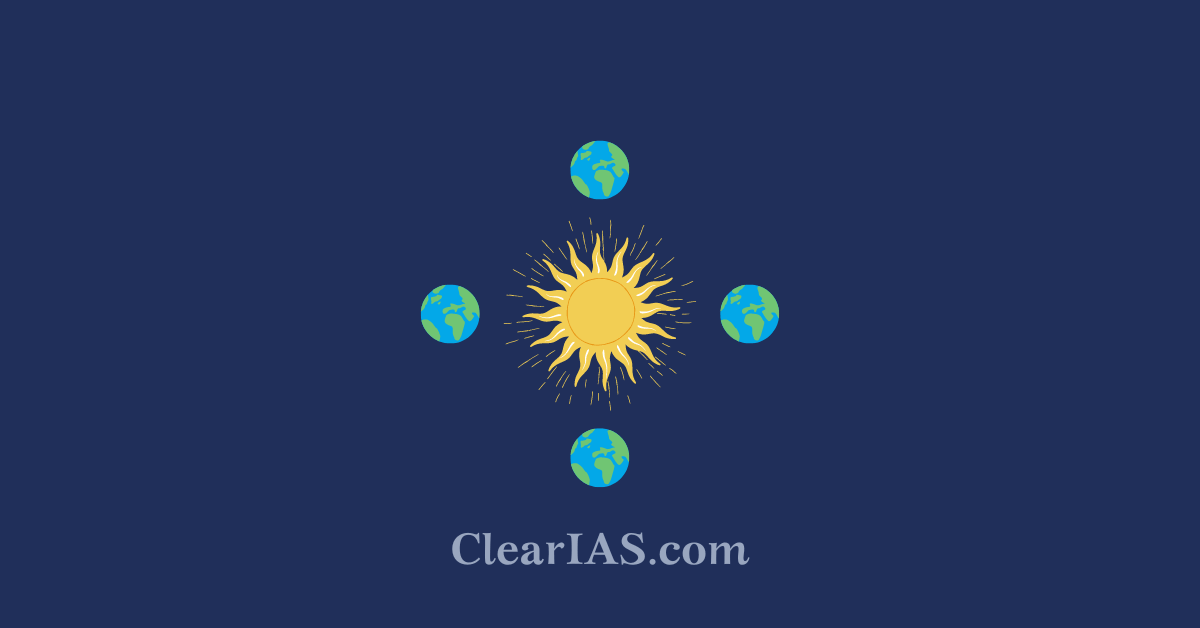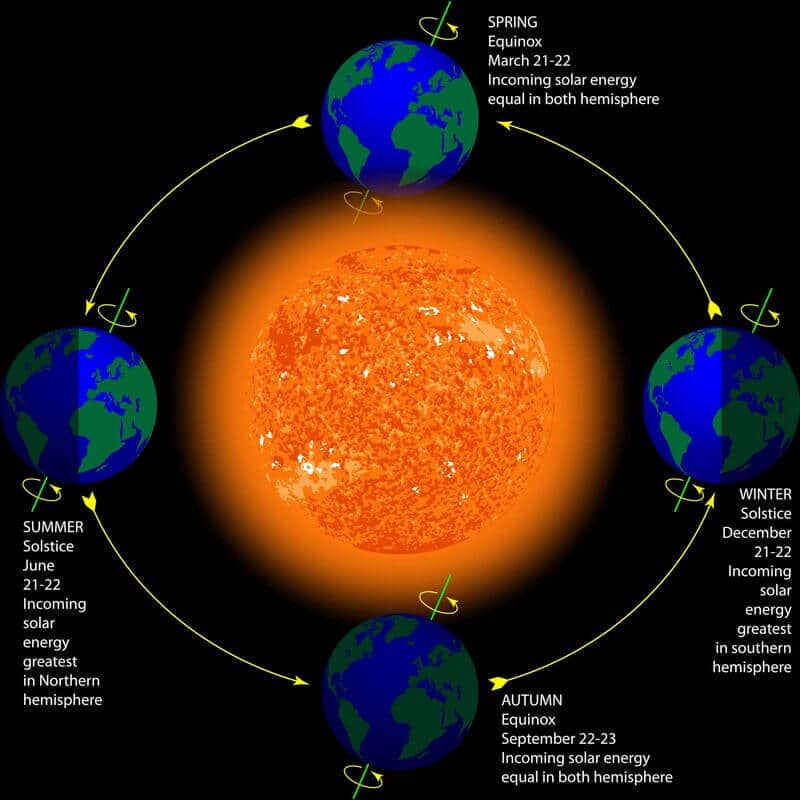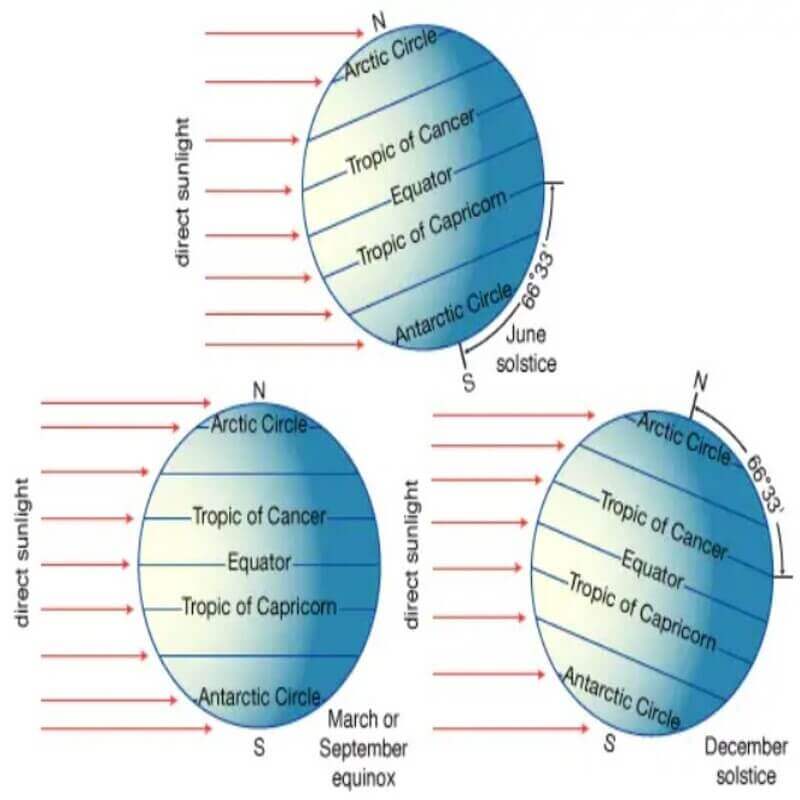
The astronomical phenomenon of solstice and equinox are familiar to most. But what do they mean, what are events related to them, and how do they influence the seasons on Earth- these are some of the in-depth questions that will be answered here. Read further to learn more.
Equinoxes and solstices are radically opposing. Equinoxes and solstices are what give rise to the earth’s seasons.
On account of the planet’s inclination towards its axis, as it circles the Sun, seasons fluctuate on Earth. This implies that various regions of the Earth receive more or less sunlight depending on the time of year.
The Sun would constantly appear above the Equator, the amount of light received at any given position would be constant, and there wouldn’t be any seasons if the Earth weren’t tilted. The equinoxes and solstices wouldn’t even need to be observed.
Solstice

A solstice is an event in which a planet’s poles are most extremely inclined toward or away from the star it orbits.
Solar declination, the latitude of Earth where the sun is directly above at noon defines solstices on our planet.
- The solar declination reaches the Tropic of Cancer in the north and the Tropic of Capricorn in the south at the solstices, which occur twice a year on Earth.
- The solar declination of the June solstice, which is observed between June 20 and June 22, is around 23.5°N (the Tropic of Cancer).
- Solar declination is around 23.5°S (the Tropic of Capricorn) during the December solstice, which is observed between December 20 and December 23.
Solar declination describes the latitude of Earth where the sun is directly overhead at noon.
The Earth’s 23.5° axial tilt as it circles the sun causes solitons and varying solar declinations.
This indicates that, depending on which hemisphere is inclined towards the sun during the year, it gets the sun’s rays at their strongest intensity.
Despite having distinct dates in the Northern and Southern Hemispheres, the solstices are referred to as the “summer solstice” and the “winter solstice,” respectively.
- The longest day of the year is the summer solstice when the sun is at its strongest and there are the most hours of daylight.
- The winter solstice has the fewest daylight hours and is the shortest day of the year.
- The June solstice is the summer solstice in the Northern Hemisphere and the winter solstice in the Southern Hemisphere.
- The December solstice is the winter solstice in the Northern Hemisphere and the summer solstice in the Southern.
Solstices occur on every planet in our solar system. The planet’s axial tilt, orbital eccentricity, and distance from the sun all have a significant role in determining the date and size of solstices.
- The axial tilt of Venus, the planet nearest to Earth, is barely 3°. Its solstices are spaced by around three months; thus, Venus suffers relatively little seasonal fluctuation.
- Our other close neighbor, Mars, has a 24° axial tilt, which is identical to Earth’s. Mars, on the other hand, orbits the sun in an orbit that is noticeably more elliptical than Earth’s because of its substantially higher orbital eccentricity. Mars has dramatic seasonal fluctuations and its solstices are spaced around 11 months apart due to its greater orbital eccentricity and axial tilt.
Science of Solstices
The solstices are felt differently depending on the latitude of Earth. The solstice marks the maximum point of dramatic exposure to daylight at the poles while scarcely being recognized near the equator.
Equatorial regions
- The Equator, at 0° latitude, receives a maximum intensity of the sun’s rays all year.
- As a result, areas near Earth’s Equator experience relatively constant sunlight and little solstice variation.
Midlatitudes
Earth’s solstices are largely marked by the transition of the subsolar point across the tropics.
- The latitude where the sun’s rays strike Earth perfectly perpendicular to its surface is known as the subsolar point. It is the location where the sun is above at midday.
- The subsolar point travels north and south over the tropics for the majority of the year before appearing at the Equator twice a year (around the equinoxes).
- The subsolar point travels to its northern and southernmost latitudes at the solstices.
- On the June solstice, the Tropic of Cancer, which is 23.5° north of the equator, receives direct sunlight.
- The subsolar point then starts moving south, and on the December solstice, vertical rays fall on the Tropic of Capricorn, which is 23.5° south of the equator.
- Every latitude in between these two extremes will be traversed by the subsolar point twice annually.
Polar regions
The Arctic and Antarctica are never reached by the subsolar point.
- The solstices represent the times when the sun is highest or lowest in the sky at the North and South Poles, respectively.
- Therefore, the solstices serve as the most extreme manifestations of the “midnight sun” and “polar night.”
- The phenomena around the summer solstice, when the sun is still visible at midnight in the weeks preceding and after the event, is referred to as the “midnight sun.”
- The weeks preceding and after the winter solstice are referred to as the “polar night” since the sun is below the horizon.
Equinox

An equinox is an event in which a planet’s subsolar point passes through its Equator.
The equinoxes are the only time when both the Northern and Southern Hemispheres experience roughly equal amounts of daytime and nighttime.
Two equinoxes occur annually on Earth: one around March 21 and the other around September 22. Even though the spring and fall equinoxes have distinct dates in the Northern and Southern Hemispheres.
- The equinoxes are occasionally referred to as the “vernal equinox” (spring equinox) and the “autumnal equinox” (fall equinox).
- In the Northern Hemisphere, the March equinox marks the spring equinox, whereas, in the Southern Hemisphere, it marks the autumnal equinox.
- In the Northern Hemisphere, the equinox in September is the autumnal equinox; in the Southern, it is the vernal equinox.
On most planets, equinoxes occur. The axial tilt and orbital properties of the planet dictate when the equinoxes occur.
- Equinoxes are very spectacular on the gas giant Saturn. The equinoxes on Saturn occur every 15 years and last for around four days.
- The magnificent ring system of Saturn revolves in the same plane as the equator of the planet.
- The rings span thousands of kilometers across, yet they are just a few kilometers broad, making them exceedingly thin.
- The rings and Saturn’s equator exactly align with the sun during Saturn’s equinoxes. Images taken from the perspective of the sun show the rings as a fine line.
Science of Equinoxes
During the equinoxes, solar declination is 0°. So, equinoxes are the only times of the year when the subsolar point is directly on the Equator.
- The apparent center of the Sun’s disc is in the same plane as the Equator during an equinox, which prevents Earth’s 23.5° axis from tilting either towards or away from the Sun.
The subsolar point moves north or south both before and after the equinox.
- The subsolar point moves northward after the March equinox when the Northern Hemisphere tilts towards the sun.
- The subsolar point crosses the Tropic of Cancer (23.5°N) around June 21.
- The subsolar point starts to move southward after this June solstice.
- The subsolar point keeps moving south after the September equinox as the Southern Hemisphere tilts towards the sun.
- The subsolar point crosses the Tropic of Capricorn (23.5°S) around December 21 which is the December solstice.
The sun terminator equally divides the Earth from north to south at an equinox, indicating equally lighted hemispheres.
- On a globe, the darkened line denoting day and night is known as the solar terminator.
- There would be 12 hours of day and night on an actual equinox.
Equatorial regions
- The sun’s rays are at their strongest all year round in the Equator, which is located at 0° latitude.
- As a result, there is little equinoctial oscillation and generally consistent sunshine in regions close to the equator.
- In general, equinoxes and celestial seasons have less of an effect than climate-driven patterns like precipitation (rainy seasons and dry seasons).
Midlatitudes
- With latitude, seasonal fluctuation gets more extreme. The difference between the lengths of day and night during the “equinox” is significantly widened by atmospheric refraction.
- The day lasts roughly eight minutes longer than the night at a latitude of around 30°.
Polar regions
- In the Arctic and Antarctic, where atmospheric refraction is most pronounced, the length of the day is approximately 12 hours, 16 minutes.
- The equinoxes in polar locations thus serve as a signal for the gradual transition from “midnight sun” to “polar night.”
- The phenomenon known as the “midnight sun” occurs when the sun never sets below the horizon, illuminating the area all day long.
- In contrast, “polar night” refers to a period when the sun never rises, putting the area in complete darkness for 24 hours.
Solstice and Equinox: Relation to seasons
We all know that the Earth follows an elliptical orbit around the sun, doing a full rotation once every 365 days.
- This implies that the average distance of 93 million miles between the Earth and the Sun fluctuates during the year.
- The Earth travels around 1.6 million miles closer to the sun during the first week of January. The perihelion is used to describe this.
- The first week of July marks the aphelion, or the moment at which the Earth is approximately 1.6 million miles further from the sun.
Although this information may seem to contradict what we know about seasons in the Northern Hemisphere, the climatic difference is not that big and is NOT the cause of our seasons.
- The Earth’s 23.5° tilt on its axis is what causes the seasons. The Northern Hemisphere has tilted away from the sun in December and towards the sun in June because the tilt’s position about space remains constant throughout the year.
The solstices and equinoxes mark the beginning and end of each season on Earth.
Solstice and Equinox: Cultural significance
The solstices currently signal the start of winter and summer, but in certain ancient societies, these were the only seasons acknowledged (autumn and spring were not there). As a result, the solstices took place in the middle of the seasons.
- Due to this, the solstices are sometimes referred to as midwinter and midsummer.
- Numerous civilizations have celebrated the solstices with celebrations and festivals since ancient times.
Like the solstices, equinoxes are historic markers of seasonal change.
- The March equinox is historically recognized as a time of rebirth and regeneration since it unofficially ushers in the spring season. Because of this, the March equinox has traditionally been observed by many civilizations as the start of a new year.
- The majority of September equinox-related cultural celebrations are linked to harvest festivities in the fall.
Read: Leap year: How does it work?
-Article by Swathi Satish






Leave a Reply